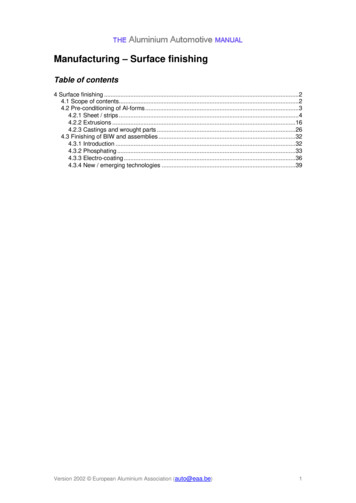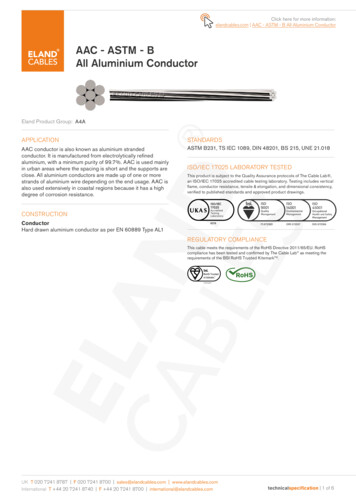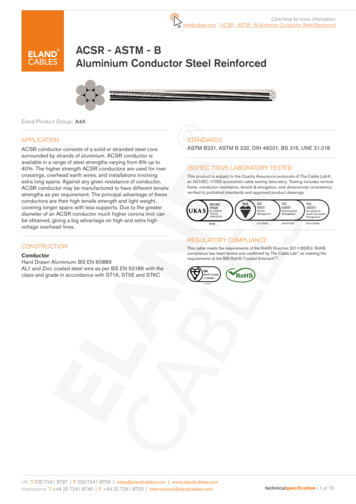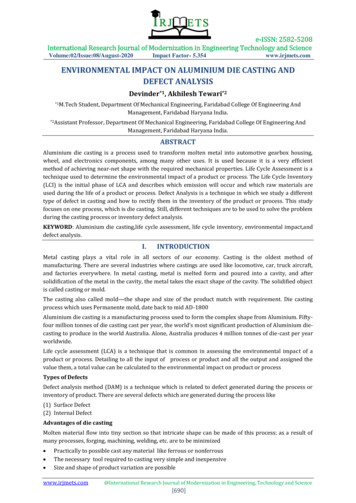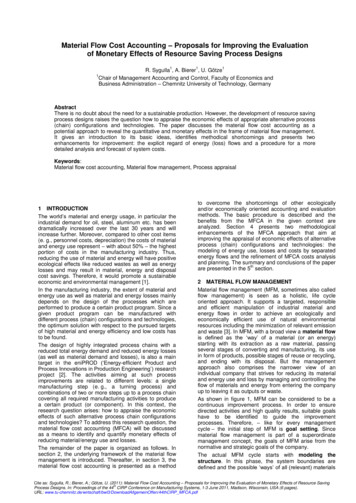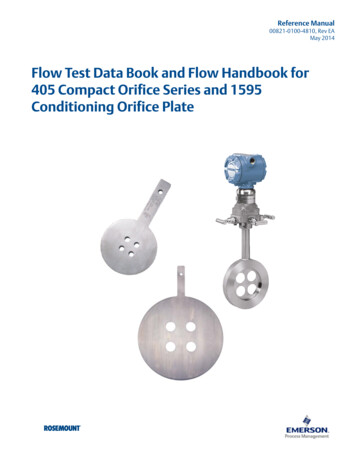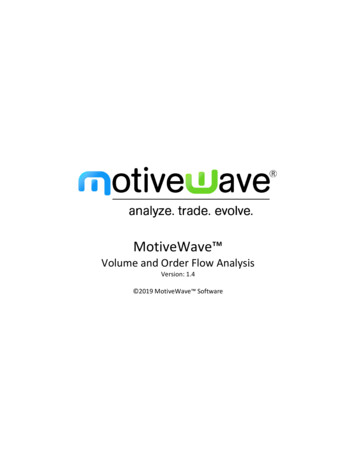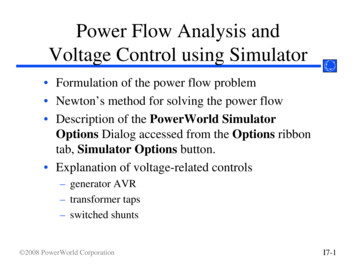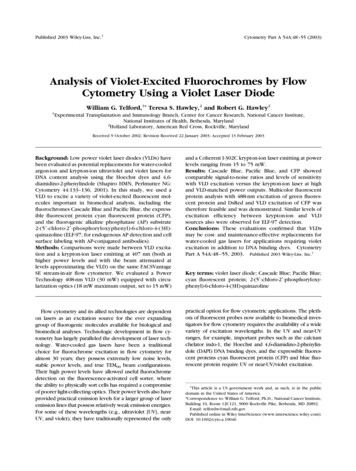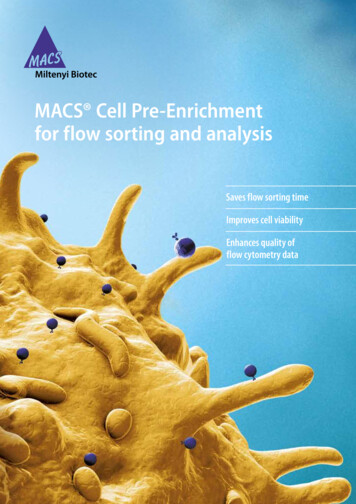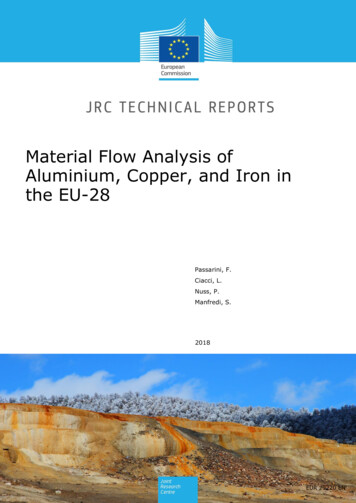
Transcription
Material Flow Analysis ofAluminium, Copper, and Iron inthe EU-28Passarini, F.Ciacci, L.Nuss, P.Manfredi, S.2018EUR 29220 EN
This publication is a Technical report by the Joint Research Centre (JRC), the European Commission’s scienceand knowledge service. It aims to provide evidence-based scientific support to the European policymakingprocess. The scientific output expressed does not imply a policy position of the European Commission. Neitherthe European Commission nor any person acting on behalf of the Commission is responsible for the use thatmight be made of this publication.Contact informationName: Simone ManfrediAddress: Joint Research Centre, Sustainable Resources Directorate, Unit D3 – Land Resources, TP29, Via EnricoFermi 2749, I - 21027 Ispra (VA) ItaliaE-mail: simone.manfredi@ec.europa.euTel.: 39 0332 786046JRC Science Hubhttps://ec.europa.eu/jrcJRC111643EUR 29220 ENPDFISBN 978-92-79-85744-7ISSN 1831-9424doi:10.2760/1079Luxembourg: Publications Office of the European Union, 2018 European Union, 2018Reuse is authorised provided the source is acknowledged. The reuse policy of European Commission documentsis regulated by Decision 2011/833/EU (OJ L 330, 14.12.2011, p. 39).For any use or reproduction of photos or other material that is not under the EU copyright, permission must besought directly from the copyright holders.How to cite this report: Passarini, F., Ciacci L., Nuss P. and Manfredi S., Material Flow Analysis of Aluminium,Copper, and Iron in the EU-28, EUR 29220 EN, Publications Office of the European Union, Luxembourg,2018, ISBN 978-92-79-85744-7, doi:10.2760/1079, JRC111643All images European Union 2018.
ContentsAcknowledgements . 3Abstract . 41 Introduction . 61.1 Monitoring of Raw Materials in the EU . 61.2 EC Raw Materials System Analysis (MSA) . 72 Goal & Scope of this Report . 93 Methodology . 113.1 Material Flow Analysis . 113.2 MSA Validation Workshop . 114 Results . 144.1 MSA for Aluminium . 144.1.1 Value chain . 144.1.2 Description of the main flows and stocks . 144.1.3 Value chain distinguishing steps occurring or not within the EU . 164.1.4 Data sources, assumptions and reliability of results . 164.1.5 Simplified Sankey Diagram . 174.2 MSA for Copper . 184.2.1 Value chain . 184.2.2 Description of the main flows and stocks . 194.2.3 Value chain distinguishing steps occurring or not within the EU . 204.2.4 Data sources, assumptions and reliability of results . 214.2.5 Simplified Sankey Diagram . 214.3 MSA for Iron . 244.3.1 Value chain . 244.3.2 Description of the main flows and stocks . 244.3.3 Value chain distinguishing steps occurring or not within the EU . 264.3.4 Data sources, assumptions and reliability of results . 274.3.5 Simplified Sankey Diagram . 274.4 Validation of MSA results . 284.4.1 Overarching Points and Comments . 284.4.2 Specific Feedback by Material . 304.5 Suggestions on the overall MSA methodology . 365 Maintaining and Updating MSAs in RMIS 2.0 . 395.1 Range of possibilities for future updates . 395.2 Complementary work . 456 Conclusions . 48i
7 References. 498 Annex . 538.1 Aluminium . 538.2 Copper . 648.3 Iron . 758.4 Overview of the indicators included in the 2016 Scoreboard. . 868.5 Details of the parameters considered in the CRM assessment . 868.6 Details of the parameters considered in the RMIS trade module . 898.7 Data overlaps of the MSA study with other raw material-related outputs . 918.8 List of MSA studies available and needs, e.g., due to the new CRM list . 94List of abbreviations. 97List of figures . 98List of tables . 100ii
AcknowledgementsThis work has been partially funded by the project ‘Support for implementation of themonitoring and evaluation scheme of the European Innovation Partnership on RawMaterials and the Raw Material Information System’ (Administrative ArrangementSI2.738536 between DG Internal Market, Industry, Entrepreneurship and SMEs (DGGROW), and the DG Joint Research Centre).The Material System Analysis (MSA) work has been carried out in collaboration withFabrizio Passarini (University of Bologna) and Luca Ciacci (University of Bologna) withsupport of the DG Joint Research Centre.The authors would like to thank all stakeholders who participated in the MSA ValidationWorkshop (see Table 2) which took place on 12 th December in Brussels or providedwritten feedback.The authors would like to thank colleagues at DG GROW Unit C.2 for valuable guidanceand feedback in the preparation of this report. Furthermore, we thank the Raw MaterialsTeam members in Unit D3 of the DG Joint Research Centre for their various inputs andlively discussions on the overall content of this report. Thanks also to Sara Antonelli andSoledad Dominguez of JRC.D.3. Unit Land Resources for their support in organizing theMSA workshop.AuthorsFabrizio Passarini, Luca Ciacci, Philip Nuss, Simone Manfredi3
AbstractThe EC Raw Materials System Analysis (MSA) was carried out in 2015 for 28 materials 1.The MSA study investigates the flows of materials through the EU economy in terms ofentry into the EU, flows through the economy, stock accumulation, and end-of-lifemanagement, e.g., through disposal or recovery in the EU-28. The MSA study is afollow-up of the “Study on Data Needs for a Full Raw Materials Flow Analysis” 2 , launchedby the European Commission in 2012 within the context of the European Raw MaterialsInitiative’s (RMI) strategy. This strategy, which is a part of the Europe 2020’s strategyfor smart, sustainable, and inclusive growth, aims at securing and improving access toraw materials for the EU.The MSA is a key building block of the European Union Raw Materials Knowledge Base(EURMKB). MSAs are an important data provider for a variety of raw material policyknowledge needs, as also reflected in the Raw Materials Information System (RMIS). TheRMIS aims to support the broad range of EU policy knowledge needs of, e.g., the EURaw Materials (RM) Scoreboard, EU Critical Raw Materials (CRM) assessment, and EUtrade negotiations. In addition, it also aims to support broader coordination beyondthese needs of other EU level data and information on raw materials. For both of theseEUKBRM/RMIS roles, MSA is a vital backbone. The MSA data sets contain key, materialspecific data and information that will support the development of a database for theRMIS. However, currently only 28 MSA studies exist (mostly for CRMs) which are quicklybecoming outdated. So far, no MSA studies exist for some of the major metals (e.g.,iron, copper, aluminium, zinc, or nickel) which are important to the EU economy, e.g.,due to the large quantities in which find use as well as due to their use in specialapplication, e.g., as alloying elements.Against this background, this report presents, firstly, detailed MSA studies for aluminium(Al), copper (Cu), and iron (Fe) and discusses, secondly, possibilities for future MSAupdate and maintenance in the RMIS.Overall, the results show that the EU-28 has a well-established industrial chain for all thethree metals covering the major value chain steps (from extraction to end-of-life).However, modest natural deposits make the region strongly dependent on imports tomeet the domestic demand of primary material 3. Only a small fraction of total primarymetal input to processing in the EU-28 is supplied from domestic extraction ranging from10% (Al) to 13% (Fe).Demand-supply dynamics and product lifetime determine the accumulation of materialsas in-use stocks and scrap generation at end-of-life. Iron, aluminium, and copper areused in large quantities (compared to other metals) and their major applicationsegments have relatively long in-use lifetimes (e.g., 50-75 years for building andconstruction). In-use stock4 for the three metals in EU-28 were estimated at about 5,300Tg for iron (or around 10 t per capita), 132 Tg for aluminium (around 260 kg per capita),73 Tg for copper (around 140 kg per capita).A consolidated recycling industry supplements primary supply of aluminium, copper andiron with inputs from secondary sources (i.e., new scrap 5 and old scrap6). In particular,old scrap recycling performance attests respectable end-of-life recycling rates -annexes-final-reportVirgin or new materials, such as iron ore, used in making products.“In-use stock” is the amount (mass) of a given material in the antroposhere, as the result of the shift inmetal stocks from the lithosphere to the anthroposphereNew scraps are generated in manufacturing processes and has typical lives of weeks to months until itsreturn to the production process. It has a known composition and origin.This is material recovered from products, and other constitute mixtures of elements alloys, plastics, and otherconstituents which need detailed processing to obtain recyclates for raw materials production.EOL-RR is the fraction of a given material that is recycled at the end of the material’s life cycle.4
for the three metals (i.e., 69% aluminium, 61% copper, 75% iron), but they are still farfrom “perfect” recycling.In addition, not all old scrap collected for recycling is processed in the EU-28, with theregion being a net-exporter of secondary material. Material loss in products at end-of-lifeand net-exports of secondary material forms constraint the closure of material cyclesand prevent the implementation of a circular economy in the EU-28 requiring theadoption of resource efficiency strategies priority.Because of its system-wide perspective on raw materials issues (encompassing all lifecycle stages of a raw material), the MSA provides an overarching data structure thatcould be based inside the RMIS database (DB) core to collect, store, and provide dataalso for other policy knowledge needs (i.e., EU CRM assessment, Circular EconomyMonitoring, Trade, Minventory, RM Scoreboard). Flows/stocks parameters of the MSAcan also be important to satisfy knowledge needs that may arise as a result of futurepolicy needs, e.g., through resilience, determining urban stocks, and other emergingissues. Equally, complete MSAs can help in the quality assurance of the underlying massbalance/data and increasing harmonization of the various data sources – which cannotbe guaranteed if only a partial picture exists.Results from an assessment of data overlaps between MSA and other policy-relatedoutputs show that current policy knowledge needs often require data on various flowsrelated to the early stages of a raw material’s life-cycle. For example, a total of 12 flows(out of 40 in total) of the MSA are also required for the 2017 CRM ass
The EC Raw Materials System Analysis (MSA) was carried out in 2015 for 28 materials. 1. The MSA study investigates the flows of materials through the EU economy in terms of entry into the EU, flows through the economy, stock accumulation, and end-of-life management, e.g., through disposal or recovery in the EU-28. The MSA study is a
